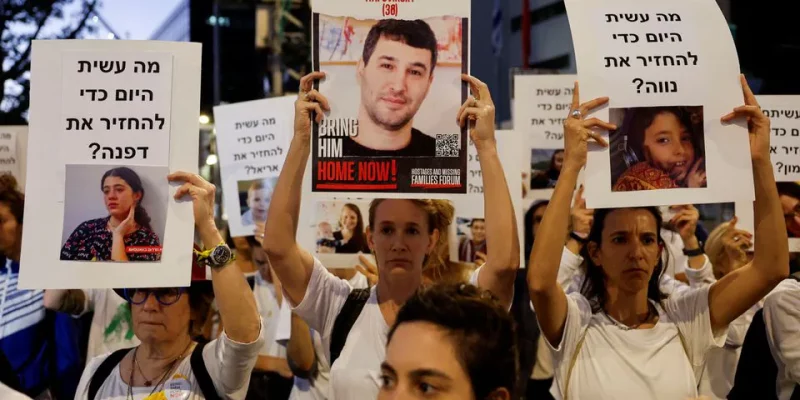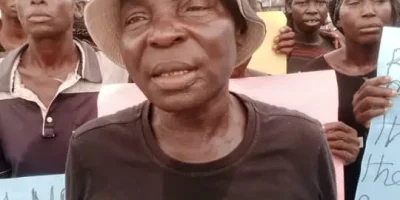By REUTERS
Israel and Hamas have agreed to a pause in fighting in Gaza to allow for the release of 50 hostages held by the militant group in exchange for 150 Palestinians held in Israeli prisons and also to allow for more aid to enter the enclave.
WHAT ARE THE DETAILS OF THE DEAL?
Under the deal, the two sides agreed to a four-day truce so that 50 women and children under the age of 19 taken hostage could be freed in return for 150 Palestinian women and teenagers in Israeli detention.
The 50 hostages, among about 240 taken by Hamas in their Oct. 7 raid on Israel, are expected to be released in batches, probably about a dozen a day, during the four-day ceasefire.
Sides to the deal have called the break in hostilities “a humanitarian pause”. The pause will be extended by a day for each additional batch of 10 hostages released, Israel said in a statement.
Hamas said Israel had agreed to halt air traffic over the north of Gaza from 10 a.m. (0800 GMT) until 4 p.m. (1400 GMT) each day of the truce and to halt all air traffic over the south for the entire period. The group said Israel agreed not to attack or arrest anyone in Gaza, and people can move freely along Salah al-Din Street, the main road along which many Palestinians have fled northern Gaza where Israel launched its ground invasion.
Qatar’s chief negotiator in ceasefire talks, Minister of State at the Foreign Ministry Mohammed Al-Khulaifi, said that under the deal there would be “no attack whatsoever. No military movements, no expansion, nothing.” He said Qatar hoped it would “be a seed to a bigger agreement and a permanent cease of fire.”
WHEN DOES THE DEAL START?
Speaking early on Wednesday, the Qatari negotiator said the timing for the start of the truce would be announced within 24 hours.
Israel delayed the start to give time for its Supreme Court to hear a challenge to the deal raised by those who say a truce was too much of a concession to Hamas. A court ruling is not expected to derail the deal.
An Egyptian source said the truce could start as early as 10 a.m. (0800 GMT) on Thursday.
HOW WILL IT BE IMPLEMENTED?
The International Committee of the Red Cross will work in Gaza to facilitate the release of the hostages, Qatar said.
The hostages are expected to be transported through Egypt, the only country apart from Israel to share a border with Gaza.
During the truce, trucks loaded with aid and fuel are expected to cross into Gaza, where 2.3 million people have been running out of food and many hospitals have shut down in part because they no longer have fuel for their generators.
WHO ARE THE HOSTAGES BEING RELEASED?
Hamas has not released a full list of names of those being held in Gaza. A U.S. official said the group had said it needed a pause “to locate and determine where people are”. Not all the hostages taken on Oct. 7 were being held by Hamas fighters.
Among the 50 women and children under the age of 19 being released by Hamas are three U.S. citizens, including a girl who turns 4 on Friday, the U.S. official said.
In addition to Israeli civilians and soldiers taken on Oct. 7, more than half the roughly 240 hostages are foreign and dual nationals from about 40 countries including Argentina, Britain, Chile, France, Germany, Portugal, Spain, Thailand and the U.S., Israel’s government has said.
WHO ARE THE PALESTINIANS BEING FREED AND WHY WERE THEY HELD?
Israel has provided a list of about 300 Palestinian prisoners who might be released – double the number of women and minors it has agreed to be freed at first – and suggested it expects more than 50 hostages to be released under the deal.
The Palestinian Prisoners Society said that as of Wednesday, 7,200 prisoners were being held by Israel, among them 88 women and 250 children 17 and under.
Most on the list of 300 are from the Israeli-occupied West Bank and Jerusalem and were held for incidents such as attempted stabbings, hurling stones at Israeli soldiers, making explosives, damaging property and having contacts with hostile organisations. None are accused of murder. Many were held under administrative detention, meaning they were held without trial.
The released prisoners could be taken by buses to the presidential headquarters of the Palestinian Authority first as in past releases, even though Palestinian President Mahmoud Abbas had no role in these truce negotiations, a Palestinian official said.
WHO NEGOTIATED THE DEAL?
Qatar played a large mediation role. Hamas has a political office in Doha and the Qatari government has kept channels of communication open with Israel, even though unlike some other Gulf Arab states it has not normalised ties with Israel.
The United States also played a crucial role, with U.S. President Joe Biden holding calls with Qatari Emir Sheikh Tamim bin Hamad Al Thani and Israeli Prime Minister Benjamin Netanyahu in the weeks leading up to the deal.
Egypt, the first Arab state to sign a peace deal with Israel and which has long played a mediation role over the decades of the Israeli-Palestinian conflict, was also involved.
WHY HAS IT TAKEN SO LONG TO NEGOTIATE?
The deal was announced 46 days after the start of the war, one of the most fierce conflicts to erupt between the two sides. Hamas fighters killed 1,200 people when they launched their raid on Israel, the biggest single-day toll on Israeli soil since its creation in 1948, and more than 13,000 people have been killed in the Israeli air strikes and land incursion since then, the most by far of any recent war.
Amid such ferocious fighting, the large number of hostages and Israel’s stated determination to wipe out Hamas in Gaza, mediating even a temporary deal, like this one, proved far more challenging than in previous conflicts.
The initial negotiations for a deal between Israel and Hamas, both sworn enemies, began within days of the Oct. 7 attack but progress was slow. This was partly because communications between the warring sides had to go via Doha or Cairo and back for every detail hammered out, such as securing a full list from Hamas for those to be released, U.S. officials said.
Even with a deal in place, the ceasefire is temporary. Hamas has said throughout the truce its “fingers remain on the trigger”. Israel has said the conflict will continue until all the hostages are freed and Hamas is eliminated.
In 2014, when Israel last launched a major land invasion in Gaza, it took 49 days for both sides to implement a ceasefire deal, but that brought major fighting to an end for several years.Cat
Israel-Hamas war: Four-day truce agreed, 50 hostages to go free
Israel and Hamas agreed on Wednesday to a ceasefire in Gaza for at least four days, to let in aid and free at least 50 hostages held by militants in the Palestinian enclave in exchange for at least 150 Palestinians jailed in Israel.
The first truce in a brutal, near seven-week-old war, reached after mediation by Qatar, was hailed around the world as a sign of progress that could ease the suffering of civilians in Israeli-besieged Gaza and bring more Israeli captives home.
Israel said the ceasefire could be extended further if more hostages were freed, and a Palestinian source said as many as 100 hostages in total could be released by the end of the month.
Hamas and allied groups captured around 240 hostages when Islamist gunmen rampaged through southern Israeli towns on Oct. 7. Previously, Hamas had released just four.
The truce was not expected to begin until Thursday morning, and the start time had yet to be officially announced as of Wednesday afternoon.
A statement by Israeli Prime Minister Benjamin Netanyahu’s office on Tuesday night said 50 women and children would be released over four days at a rate of at least 10 daily. Beyond that, the truce could be extended day by day as long as an additional 10 hostages were freed per day.
Israel’s justice ministry published a list of 300 names of Palestinian prisoners who could be freed.
“Israel’s government is committed to return all the hostages home. Tonight, it approved the proposed deal as a first stage to achieving this goal,” said the government statement.
Hamas said the initial 50 hostages would be released in exchange for 150 Palestinian women and children imprisoned in Israel. Hundreds of trucks of humanitarian, medical and fuel supplies would enter Gaza, while Israel would halt all air sorties over southern Gaza and maintain a daily six-hour daytime no-fly window in the north, the enclave’s ruling Islamists said.
Israel has subjected Gaza to siege and relentless bombardment since the Hamas attack, which killed 1,200 people, mostly civilians, according to Israeli tallies. Since then, over 14,000 Gazans have been killed, around 40% of them children, according to medical officials in the territory.
Qatar’s chief negotiator in ceasefire talks, Minister of State at the Foreign Ministry Mohammed Al-Khulaifi, told Reuters the truce meant there would be “no attack whatsoever. No military movements, no expansion, nothing”.
Qatar hopes the deal “will be a seed to a bigger agreement and a permanent cease of fire…That’s our intention,” he said.
Pending the start of the truce there was no let-up in fighting. As morning broke, smoke from explosions rose above northern Gaza in live Reuters video from across the border fence.
Riyad al-Maliki, foreign minister in the Palestinian Authority government based in the West Bank, said an entire extended family had been killed on Wednesday in Jabalia on Gaza’s northern edge.
“Only this morning, from the Qadoura family in Jabalia, 52 people have been wiped out completely, killed,” he said. “I have the list of the names, 52 of them, they were wiped out completely from grandfather to grandchildren.”
Israel’s military released footage of soldiers shooting in narrow alleyways and said it had carried out air strikes. Its “forces continue to operate within the (Gaza) Strip’s territory to destroy terrorist infrastructure, eliminate terrorists and locate weaponry”, it said.
An Egyptian security source said mediators sought a start time of 10 a.m. on Thursday for the truce, though this was still awaiting confirmation from the Israelis, with Hamas seeking a few hours from the start to begin freeing hostages. A spokesperson for Israel’s Defence Ministry said the truce would likely take hold “sometime tomorrow”.
‘WHAT TRUCE CAN THERE BE?’
The truce deal is a first small step towards peace in the most violent ruction of the 75-year-old Palestinian-Israeli conflict. The past seven weeks have shocked the world because of the suffering of civilians on both sides, beginning with the killing of Israeli families in their homes and continuing with destruction rained down on Gaza, home to 2.3 million people.
“What truce can there be after what happened to us? We are all are dead people,” said Mona, a woman in Gaza whose nieces and nephews were among those killed by an Israeli air strike that hit the home of the Seyam family.
“This will not bring back what we lost, will not heal our hearts or make up for the tears we shed.”
U.S. President Joe Biden was among international leaders who welcomed the deal. Three Americans, including a 3-year-old girl whose parents were killed on Oct. 7, are expected to be among the hostages to be released, a senior U.S. official said.
Saudi Foreign Minister Prince Faisal bin Farhan Al Saud said the agreed expansion of access for humanitarian aid should become permanent: “Whatever humanitarian access now increases as a result of this hostage deal must remain in place and must be built upon.”
U.N. Secretary-General Antonio Guterres welcomed the agreement as “an important step in the right direction, but much more needs to be done to end the suffering”.
Both Israel and Hamas, however, said the pause in hostilities would not halt their broader missions.
“We are at war and we will continue the war until we achieve all our goals. To destroy Hamas, return all our hostages and ensure that no entity in Gaza can threaten Israel,” Netanyahu said in a recorded message.
Hamas said in its statement: “As we announce the striking of a truce agreement, we affirm that our fingers remain on the trigger, and our victorious fighters will remain on the look-out to defend our people and defeat the occupation.”








Comments